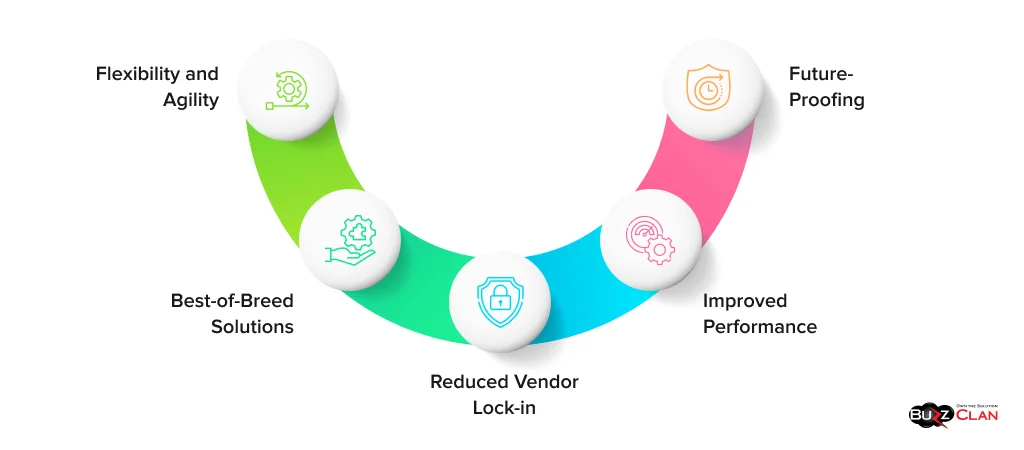MACH Architecture: The Complete Guide to Modern Digital Infrastructure for Enterprise Success
Deepak Desai
Jul 30, 2025
Enterprises are transitioning from monolithic systems to agile, scalable architectures that can adapt to changing business requirements. MACH architecture has emerged as the gold standard for organizations seeking to build future-ready digital platforms that deliver exceptional customer experiences while maintaining operational efficiency.
MACH architecture represents a fundamental shift from traditional, rigid technology stacks to flexible, composable systems that can evolve in response to changing business needs. This comprehensive guide explores everything you need to know about MACH architecture, from its core principles to real-world implementation strategies.
What Is MACH Architecture? Understanding the Foundation
MACH architecture is a technology approach that promotes the use of Microservices-based, API-first, Cloud-native, and Headless technologies. This architecture pattern enables organizations to build digital experiences that are flexible, scalable, and adaptable to changing market demands.
The MACH architecture concept emerged from the need to address the limitations of traditional monolithic systems, which often create technology silos and hinder innovation. By embracing a composable architecture approach, organizations can select best-of-breed solutions for each component of their technology stack, creating a more resilient and adaptable digital infrastructure.
Unlike traditional architectures that lock organizations into specific vendor ecosystems, MACH architecture promotes vendor neutrality, enabling businesses to select the best tools for their unique requirements. This approach aligns perfectly with modern digital transformation initiatives that prioritize agility and innovation.
Breaking Down the MACH Architecture Principles
Microservices: Building Blocks of Modern Applications
Microservices form the foundation of MACH architecture by breaking down monolithic applications into smaller, independent services. Each microservice handles a specific business function and can be developed, deployed, and scaled independently. This approach offers several advantages:
- Independent Development and Deployment: Teams can work on different microservices simultaneously without affecting other parts of the system. This parallel development capability significantly reduces time-to-market for new features and improvements.
- Technology Diversity: Different microservices can utilize various programming languages, databases, and frameworks tailored to their specific requirements. This flexibility enables organizations to select the most suitable technology for each service.
- Fault Isolation: When one microservice fails, it doesn’t bring down the entire system. Other services continue to function, ensuring better overall system resilience and availability.
- Scalability: Individual microservices can be scaled according to demand, enabling more efficient resource utilization and cost optimization.
Further Reading
API-First: The Integration Layer
The API-first principle ensures that all microservices expose their functionality through well-defined APIs. This approach establishes a standardized communication layer that facilitates seamless integration between various services and third-party systems.
- Standardized Communication: APIs provide a consistent interface for service communication, making it easier to integrate new services or replace existing ones without disrupting the entire system.
- Developer Experience: Well-documented APIs enable faster development by providing precise specifications for how services interact with each other.
- Future-Proofing: API-first design ensures that services can evolve independently while maintaining backward compatibility, protecting investments in existing integrations.
- Third-Party Integration: APIs facilitate integration with external services, enabling organizations to leverage best-of-breed solutions from different vendors.
Cloud-Native: Built for the Cloud
Cloud-native technologies are specifically designed to leverage the full capabilities of cloud computing. This includes containerization, orchestration, and serverless computing models that provide unprecedented scalability and reliability.
- Containerization: Services are packaged in containers, providing consistent runtime environments across various cloud platforms. This approach enables better resource utilization and simplified deployment processes.
- Auto-Scaling: Cloud-native applications can automatically scale up or down based on demand, ensuring optimal performance while controlling costs.
- Global Distribution: Cloud platforms enable applications to be deployed across multiple regions, improving performance for international users and providing disaster recovery capabilities.
- Managed Services: Cloud providers offer managed services for databases, monitoring, security, and other infrastructure components, reducing operational overhead for development teams.
Headless: Separation of Concerns
The headless principle separates the presentation layer (front-end) from the business logic and data layer (back-end). This separation enables greater flexibility in delivering content and functionality across various channels and devices.
- Multi-Channel Delivery: Content and functionality can be delivered to websites, mobile apps, IoT devices, and other digital touchpoints through APIs.
- Frontend Freedom: Development teams can choose the most appropriate frontend technologies for each channel without being constrained by backend limitations.
- Content Management: Headless content management systems enable content creators to focus on content creation, while developers handle the presentation logic.
- Personalization: A separated architecture enables more sophisticated personalization and A/B testing capabilities across various channels.
MACH Architecture vs Traditional Monolithic Systems
Traditional monolithic architectures have served organizations well for decades, but they present significant challenges in today’s fast-paced digital environment. Understanding the differences between MACH and monolithic approaches is crucial for making informed architectural decisions.
Limitations of Monolithic Architecture
- Technology Lock-in: Monolithic systems often force organizations to use specific technologies throughout the entire stack, limiting flexibility and innovation opportunities.
- Scaling Challenges: The entire application must be scaled as a unit, even if only specific components require additional resources. This approach leads to inefficient resource utilization and higher costs.
- Development Bottlenecks: All development work must be coordinated within a single codebase, which creates dependencies and slows down development cycles.
- Risk of System-Wide Failures: A failure in any component can bring down the entire application, creating significant business risk.
- Vendor Dependency: Organizations become heavily dependent on a single vendor’s roadmap and pricing decisions, reducing negotiating power and flexibility.
Advantages of MACH Architecture

- Flexibility and Agility: Organizations can quickly adapt to changing business requirements by replacing or upgrading individual components without affecting the entire system.
- Best-of-Breed Solutions: Each component can be selected based on its specific merits, ensuring the best possible solution for each business requirement.
- Reduced Vendor Lock-in: The composable nature of MACH architecture reduces dependency on any single vendor, improving negotiating position and reducing risk.
- Improved Performance: Individual components can be optimized for their specific use cases, resulting in enhanced overall system performance.
- Future-Proofing: The modular architecture enables easier adoption of new technologies and adaptation to changing market conditions.
Core Benefits of Implementing MACH Architecture
Enhanced Business Agility
MACH architecture enables organizations to respond quickly to market changes and customer demands. The modular nature of the architecture enables rapid experimentation and iteration, allowing businesses to stay ahead of the competition.
- Time-to-Market Acceleration: New features and capabilities can be developed and deployed independently, significantly reducing the time required to bring innovations to market.
- Risk Mitigation: The ability to make changes to individual components without affecting the entire system reduces the risk associated with digital initiatives.
- Business Model Flexibility: Organizations can easily adapt their technology stack to support new business models or market opportunities.
Improved Customer Experience
By enabling personalized, omnichannel experiences, MACH architecture helps organizations deliver superior customer experiences that drive loyalty and revenue growth.
- Consistent Experience: Customers receive a consistent experience across all touchpoints, whether they use a website, mobile app, or other digital channels.
- Personalization: The flexible architecture enables sophisticated personalization engines that can deliver tailored experiences based on customer behavior and preferences.
- Performance Optimization: Individual components can be optimized for specific use cases, ensuring fast loading times and responsive interactions.
Cost Optimization
While the initial investment in MACH architecture may be higher than traditional approaches, the long-term cost benefits are substantial.
- Resource Efficiency: Components can be scaled independently based on actual demand, eliminating waste and optimizing infrastructure costs.
- Reduced Licensing Costs: The ability to choose best-of-breed solutions for each component often results in lower overall licensing costs compared to enterprise suites.
- Operational Efficiency: Automated deployment and scaling capabilities reduce operational overhead and human resource requirements.
Innovation Enablement
MACH architecture creates an environment where innovation can flourish by removing technical barriers and enabling experimentation.
- Technology Adoption: New technologies can be adopted incrementally without requiring complete system overhauls.
- Developer Productivity: Developers can focus on building business value rather than dealing with technical constraints imposed by monolithic systems.
- Competitive Advantage: The ability to quickly implement new capabilities and adapt to market changes provides significant competitive advantages.
MACH Architecture Implementation: A Strategic Approach
Implementing MACH architecture requires careful planning and a phased approach to ensure success. Organizations should develop a comprehensive strategy that addresses technical, organizational, and business considerations.

Assessment and Planning Phase
- Current State Analysis: Conduct a thorough assessment of existing systems to identify pain points, dependencies, and opportunities for improvement.
- Business Objectives Alignment: Ensure that the MACH implementation strategy aligns with broader business objectives and digital transformation goals.
- Technology Stack Evaluation: Assess current technology capabilities and identify gaps that need to be addressed during the transition.
- Resource Planning: Determine the skills, budget, and timeline required for successful implementation.
Architecture Design
- Service Decomposition: Identify how existing monolithic applications can be broken down into microservices, ensuring proper separation of concerns and minimal dependencies.
- API Strategy: Develop a comprehensive API strategy that defines standards for service communication, documentation, and governance.
- Data Architecture: Design data architecture that supports microservices while ensuring data consistency and governance requirements are met.
- Security Framework: Implement security measures that address the unique challenges of distributed architectures, including service-to-service authentication and data protection.
Technology Selection
- Microservices Platforms: Select suitable platforms for microservices development and deployment, considering factors such as developer experience, scalability, and operational requirements.
- API Management: Select API management solutions that provide the necessary features for API governance, monitoring, and security.
- Cloud Platform: Choose cloud platforms that align with organizational requirements for scalability, compliance, and cost optimization.
- Frontend Technologies: Select frontend frameworks and technologies that provide the flexibility and performance required for multi-channel delivery.
Implementation Roadmap
- Phased Approach: Implement MACH architecture in phases, starting with less critical components to gain experience and reduce risk.
- Pilot Projects: Begin with pilot projects that demonstrate the value of MACH architecture while building organizational capabilities.
- Migration Strategy: Develop a migration strategy that minimizes disruption to existing operations while progressively modernizing the technology stack.
- Change Management: Implement change management processes that enable teams to adapt to new ways of working and emerging technology approaches.
MACH Architecture Components and Technologies
Microservices Technologies
- Container Orchestration: Kubernetes has emerged as the de facto standard for container orchestration, providing automated deployment, scaling, and management of containerized applications.
- Service Mesh: Technologies like Istio and Linkerd provide service-to-service communication capabilities, including load balancing, security, and observability.
- Messaging Systems: Apache Kafka, RabbitMQ, and Amazon SQS enable asynchronous communication between microservices, improving system resilience and performance.
API Technologies
- API Gateways: Solutions such as Kong, Ambassador, and AWS API Gateway offer centralized management of API traffic, security, and monitoring.
- GraphQL: This query language enables more efficient data fetching and provides a better developer experience for frontend applications.
- OpenAPI Specification: Standardized API documentation format that improves developer experience and enables automated tooling.
Cloud-Native Platforms
- Container Platforms: Docker provides standardized containerization capabilities, while platforms like OpenShift and Google Kubernetes Engine offer enterprise-grade orchestration.
- Serverless Computing: AWS Lambda, Azure Functions, and Google Cloud Functions enable event-driven architectures with automatic scaling and pay-per-use pricing.
- Database Services: Managed database services, such as Amazon RDS, Azure Cosmos DB, and Google Cloud Spanner, provide scalable data storage with reduced operational overhead.
Headless Technologies
- Content Management Systems: Headless CMS solutions, such as Contentful, Strapi, and Sanity, provide content management capabilities without requiring prescriptive frontend implementations.
- Commerce Platforms: Headless commerce solutions, such as Commercetools and Elastic Path, enable flexible e-commerce implementations across multiple channels.
- Front-end frameworks, such as React, Vue.js, and Angular, provide modern front-end development capabilities with component-based architectures.
Real-World MACH Architecture Examples
E-commerce Implementation
A global retailer implemented MACH architecture to support their omnichannel commerce strategy. The implementation included:
- Microservices: Separate services for product catalog, inventory management, order processing, payment handling, and customer management.
- API-First: All services exposed RESTful APIs with comprehensive documentation, enabling integration with web, mobile, and partner channels.
- Cloud-Native: Deployed on AWS using Kubernetes for orchestration, with auto-scaling capabilities to handle traffic spikes during peak shopping periods.
- Headless: Implemented a headless commerce platform that delivered content to web, mobile apps, in-store kiosks, and social media channels.
- Results: 40% improvement in time-to-market for new features, 25% reduction in infrastructure costs, and 60% increase in developer productivity.
Media and Publishing Platform
A digital media company modernized its content delivery platform using MACH principles:
- Content Microservices: Separate services for content creation, editorial workflow, asset management, and content delivery.
- API Strategy: GraphQL APIs offer efficient data access for various client applications, minimizing over-fetching and enhancing performance.
- Multi-Cloud Deployment: Utilized multiple cloud providers for content delivery, ensuring global performance and redundancy.
- Headless CMS: Implemented a headless content management system that supported web, mobile apps, and syndication to partner platforms.
- Outcomes: 50% reduction in content publishing time, improved global content delivery performance, and enhanced ability to create personalized content experiences.
Financial Services Platform
A fintech company built its lending platform using MACH architecture:
- Service Decomposition: Separated services for customer onboarding, credit scoring, loan origination, document management, and compliance reporting.
- Security-First APIs: Implemented OAuth 2.0 and OpenID Connect for secure service-to-service communication, meeting financial industry security requirements.
- Cloud Security: Utilized cloud-native security services for encryption, key management, and compliance monitoring.
- Omnichannel Interface: Headless design enabled consistent experiences across web applications, mobile apps, and partner integrations.
- Benefits: 70% faster loan approval process, improved regulatory compliance capabilities, and enhanced customer experience across all channels.
Further Reading
Common Challenges and Solutions in MACH Implementation
Technical Challenges
- Distributed System Complexity: Managing multiple microservices introduces complexity in monitoring, debugging, and maintaining system reliability.
Solution: Implement comprehensive observability solutions that provide distributed tracing, centralized logging, and performance monitoring across all services.
- Data Consistency: Maintaining data consistency across distributed services can be challenging, especially for complex business transactions.
Solution: Implement event-driven architectures with eventual consistency models, utilizing patterns such as the saga pattern for distributed transactions.
- Network Latency: Service-to-service communication over networks can introduce latency compared to in-process calls in monolithic applications.
Solution: Optimize service granularity, implement caching strategies, and use efficient communication protocols like gRPC for internal service communication.
Organizational Challenges
- Skill Gaps: Teams may lack experience with microservices, container technologies, and cloud-native development practices.
Solution: Invest in training and development programs, consider hiring experienced practitioners, and implement mentorship programs to transfer knowledge.
- Cultural Resistance: Organizations may resist changes to established development and deployment practices.
Solution: Implement change management programs that communicate the benefits of MACH architecture and provide support during the transition.
- Team Structure: Traditional organizational structures may not align with microservices development practices.
Solution: Adopt cross-functional team structures that align with service boundaries, implementing practices like DevOps and site reliability engineering.
Implementation Challenges
- Migration Complexity: Migrating from monolithic systems to MACH architecture can be complex and disruptive to ongoing operations.
Solution: Implement the strangler fig pattern for gradual migration, starting with new features and progressively modernizing existing functionality.
- Service Boundaries: Defining appropriate service boundaries requires a deep understanding of business domains and technical dependencies.
Solution: Utilize domain-driven design principles to define service boundaries, engaging business stakeholders in the architecture design process.
- Integration Testing: Testing distributed systems requires different approaches than those used for monolithic applications.
Solution: Implement contract testing, service virtualization, and end-to-end testing strategies that address the complexity of distributed systems.
MACH Architecture Best Practices
Design Principles
- Domain-Driven Design: Use domain-driven design principles to identify service boundaries that align with business capabilities and organizational structure.
- Single Responsibility: Ensure each microservice has a single, well-defined responsibility that can be understood and maintained by a small team.
- Data Ownership: Each microservice should own its data and expose it only through well-defined APIs, thereby avoiding the use of shared databases across services.
- Stateless Design: Design services to be stateless whenever possible, storing state in external systems like databases or caches.
Development Practices
- API-First Development: Design APIs before implementing services, ensuring that interfaces meet the needs of consumers and follow consistent design patterns.
- Continuous Integration/Continuous Deployment: Implement CI/CD pipelines that enable frequent, reliable deployments of individual services.
- Testing Strategy: Implement comprehensive testing strategies that include unit tests, integration tests, contract tests, and end-to-end tests.
- Documentation: Maintain comprehensive documentation for APIs, service dependencies, and deployment procedures.
Operational Excellence
- Monitoring and Observability: Implement comprehensive monitoring solutions that provide visibility into service health, performance, and dependencies.
- Security by Design: Implement security measures at every layer, including service-to-service authentication, data encryption, and network security.
- Disaster Recovery: Design systems with redundancy and failover capabilities, implementing disaster recovery procedures for critical services.
- Capacity Planning: Monitor service performance and usage patterns to plan for capacity requirements and optimization opportunities.
Further Reading
MACH Architecture Security Considerations
Security in MACH architecture requires a different approach compared to traditional monolithic systems. The distributed nature of microservices introduces new security challenges that must be addressed comprehensively.
Identity and Access Management
- Service Identity: Each microservice should have a unique identity that other services and infrastructure components can verify.
- Authentication and Authorization: Implement robust authentication and authorization mechanisms that support service-to-service communication and control user access.
- Token Management: Utilize secure token formats, such as JSON Web Tokens (JWT), for service communication, and implement proper token validation and expiration policies.
Network Security
- Service Mesh Security: Implement service mesh technologies that provide encrypted communication between services and network-level security policies.
- API Gateway Security: Use API gateways to implement security policies, rate limiting, and threat detection at the edge of your system.
- Network Segmentation: Implement network segmentation strategies that limit the blast radius of potential security breaches.
Data Protection
- Encryption at Rest and in Transit: Ensure all data is encrypted both when stored and when transmitted between services.
- Data Classification: Implement data classification schemes that ensure the application of appropriate security measures based on data sensitivity.
- Privacy Compliance: Design systems to support privacy regulations, such as GDPR and CCPA, by implementing data portability and deletion capabilities.
MACH Architecture and Composable Commerce
MACH architecture has become particularly important in the commerce space, where businesses need to deliver personalized experiences across multiple channels while maintaining agility to respond to market changes.
Composable Commerce Benefits
- Channel Flexibility: Businesses can deliver commerce experiences across web, mobile, social media, marketplaces, and emerging channels using the same backend services.
- Vendor Selection: Organizations can choose best-of-breed solutions for various commerce functions, such as product information management, order management, and payment processing.
- Customization: The modular architecture enables deep customization of commerce experiences without the constraints of monolithic platforms.
- Integration Capabilities: APIs enable seamless integration with existing enterprise systems, such as ERP, CRM, and marketing automation platforms.
Commerce-Specific Considerations
- Real-Time Inventory: Implement real-time inventory management across all channels to prevent overselling and improve customer experience.
- Order Orchestration: Design order management systems that can handle complex fulfillment scenarios, including drop-shipping, split shipments, and returns.
- Payment Flexibility: Support multiple payment methods and processors, allowing businesses to tailor their offerings to different markets and customer preferences.
- Personalization Engines: Implement personalization capabilities that can deliver relevant product recommendations and content across all touchpoints.
Future Trends in MACH Architecture
Artificial Intelligence Integration
- AI-Powered Microservices: Individual microservices are increasingly incorporating AI capabilities for tasks like recommendation engines, fraud detection, and automated customer service.
- Machine Learning Operations (MLOps): Organizations are implementing MLOps practices to manage machine learning models as part of their MACH architecture, enabling continuous deployment and monitoring of AI capabilities.
- Intelligent Automation: AI is being used to automate various aspects of MACH architecture management, including performance optimization, capacity planning, and incident response.
Edge Computing
- Edge Microservices: Organizations are deploying microservices closer to users by utilizing edge computing platforms, thereby reducing latency and enhancing the user experience.
- Distributed Architecture: The MACH architecture is evolving to support distributed deployment across cloud and edge environments, enabling new use cases such as IoT and real-time applications.
- Content Delivery: Edge computing is being integrated with headless content management systems to deliver personalized content with minimal latency.
Sustainability and Green Computing
- Resource Optimization: MACH architecture’s ability to scale individual components independently contributes to more efficient resource utilization and reduced environmental impact.
- Sustainable Development: Organizations are incorporating sustainability considerations into their MACH architecture decisions, choosing technologies and practices that minimize energy consumption.
- Green Metrics: New metrics and monitoring tools are emerging to track the environmental impact of MACH architecture implementations.
Building Your MACH Architecture Team
Successful MACH architecture implementation requires teams with diverse skills and experience. Organizations need to invest in building capabilities across multiple disciplines.
Essential Roles
- Solutions Architects: Experienced architects who can design distributed systems and make technology decisions that align with business objectives.
- DevOps Engineers: Professionals with expertise in container orchestration, CI/CD pipelines, and cloud platform management.
- Frontend Developers: Developers with experience in modern frontend frameworks and multi-channel application development.
- Backend Developers: Developers skilled in microservices development, API design, and distributed system patterns.
- Site Reliability Engineers: Professionals focused on system reliability, monitoring, and operational excellence in distributed environments.
Skills Development
- Container Technologies: Training in Docker containerization best practices, Kubernetes, and container orchestration platforms is essential for MACH architecture teams.
- Cloud Platforms: A deep understanding of cloud services and platforms is essential for implementing cloud-native architectures.
- API Design: A thorough understanding of API design principles, documentation standards, and API management tools is crucial for success.
- Security Practices: Knowledge of security best practices for distributed systems, including authentication, authorization, and data protection.
Team Organization
- Cross-Functional Teams: Organize teams around business capabilities rather than technical functions, ensuring each team can deliver value independently and effectively.
- DevOps Culture: Foster a culture of collaboration between development and operations teams, implementing shared responsibility for system reliability.
- Continuous Learning: Establish programs for constant learning and skill development, as MACH technologies evolve rapidly.
Measuring MACH Architecture Success
Organizations implementing MACH architecture need comprehensive metrics to measure success and identify areas for improvement.
Technical Metrics
- System Performance: Monitor response times, throughput, and availability across all services to ensure the architecture delivers expected performance benefits.
- Deployment Frequency: Track the frequency of new features and update deployments to measure the impact of the MACH architecture on development velocity.
- Service Reliability: Monitor error rates, uptime, and service dependency health to ensure system reliability meets business requirements.
- Resource Utilization: Track infrastructure costs and resource utilization to measure the efficiency benefits of MACH architecture.
Business Metrics
- Time-to-Market: Measure the time required to deliver new features and capabilities, demonstrating the agility benefits of MACH architecture.
- Customer Experience: Track customer satisfaction, conversion rates, and engagement metrics across all channels to measure improvements in the customer experience.
- Revenue Impact: Monitor revenue attribution across different channels and touchpoints to measure the business impact of omnichannel capabilities.
- Cost Optimization: Track total cost of ownership, including development, infrastructure, and operational costs.
Operational Metrics
- Team Productivity: Measure developer productivity, including feature delivery velocity and code quality metrics.
- Incident Response: Track mean time to detection and resolution for system incidents, measuring the operational benefits of MACH architecture.
- Security Posture: Monitor security metrics, including vulnerability management, compliance status, and incident frequency.
- Scalability Performance: Track how well the system handles traffic spikes and growth, measuring the scalability benefits of the architecture.
Ready to unlock the full potential of MACH architecture for your organization? Let’s Talk!
BuzzClan’s expert team specializes in helping enterprises design, implement, and optimize MACH architecture solutions for tangible business results. Our services cover assessment, technology selection, planning, and ongoing improvement to maximize your investment.
FAQs

Get In Touch






